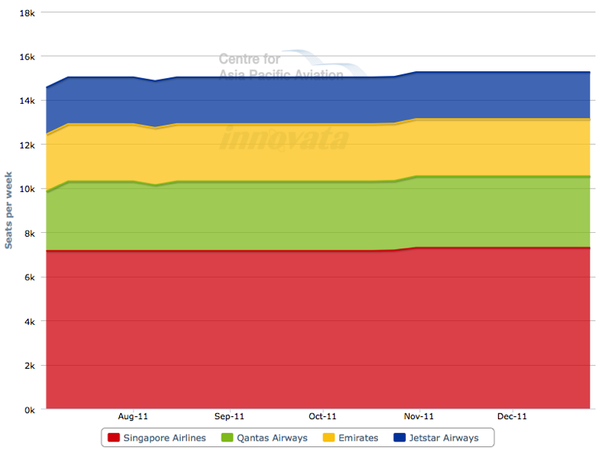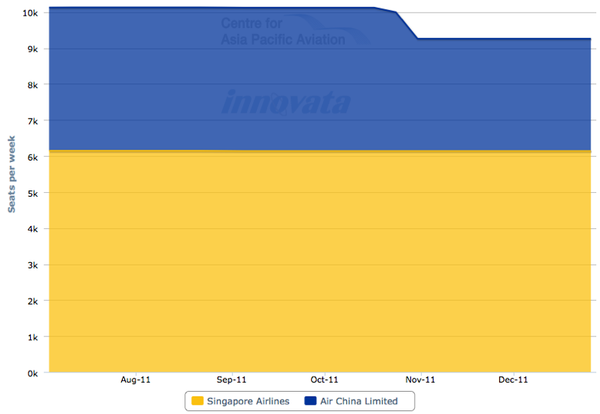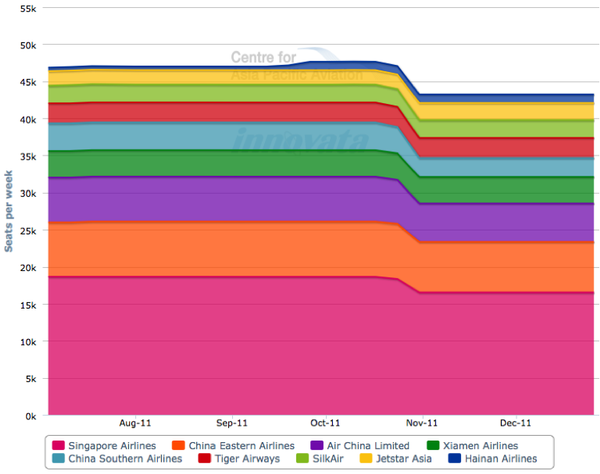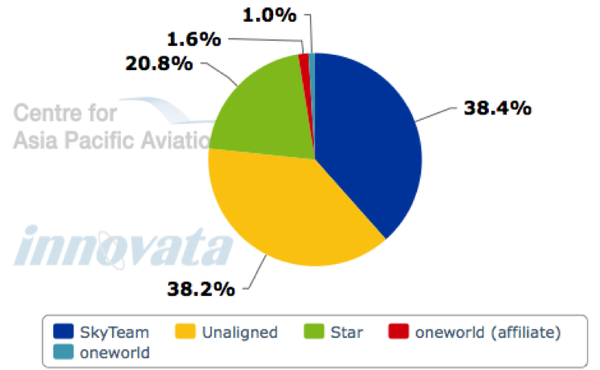Jetstar to launch Singapore-Beijing service as part of pan-Asian expansion
Jetstar has unveiled plans to launch service to Beijing from Melbourne via Singapore on 24-Nov-2011. The service will enable the LCC to take advantage of the growing and lucrative Chinese tourism market with Beijing to become the Jetstar Group's ninth destination in China. The service also marks a return of Qantas Group to Beijing following Qantas' withdrawal from the market in early 2009 and builds Jetstar's Singapore hub network to 23 destinations.
- Jetstar plans to launch service to Beijing from Melbourne via Singapore, targeting the growing Chinese tourism market.
- The service will be operated daily using a two-class, 310-seat A330 from Jetstar's Australian fleet.
- Jetstar aims to undercut Air China's fares by at least 40% and sees 200 Chinese destinations as profitable prospects in the next 20 years.
- The service is primarily aimed at leisure travelers, with a Singapore stop-over and Beijing slot allocations making it less appealing for business passengers.
- Jetstar's expansion into Beijing is part of its pan-Asia growth strategy, with China predicted to become its biggest future market.
- China is Australia's fastest-growing inbound tourism market, with visitor volumes and values increasing significantly in recent years.
The expansion into China is part of the carrier's pan-Asia strategy, with CEO Bruce Buchanan previously stating the carrier needs to increase its operations in the high growth Asian market by more than 20% over the next five years to maintain its market share. Mr Buchanan stated market growth of up to 20% in the LCC segment presents a large opportunity for the carrier but added: "To be gaining relative share or position in our segment, we need to be growing faster than that. So the maths is pretty straightforward. We know the challenge, which is now finding the routes and growth opportunities." Mr Buchanan also stated the carrier sees 200 Chinese destinations as profitable prospects in the next 20 years.
The expansion of Jetstar's footprint in Asia also comes amid a review by Qantas of its loss-making international operations, with Jetstar likely to takeover some of these Asian routes, potentially to leisure-focussed destinations including Bangkok.
Service to be operated by Jetstar Australia and add 4340 seats on the sector
The Jetstar service, which is subject to regulatory approval from authorities in China, Singapore and Australia, will be operated daily using a two-class, 310-seat A330 from Jetstar's Australian fleet, adding 4340 weekly seats between the destinations. The services will be operated by Jetstar Australia, not its Jetstar Asia subsidiary, and will be a codeshare with Qantas. Jetstar Australia already operates one daily flight on the Melbourne-Singapore route, which will essentially be extended to include a second leg to Beijing.
Air China is currently the sole operator on the Melbourne-Beijing sector, with 260 weekly seats at present, increasing to 780 weekly seats from 31-Oct-2011 (Air China is also the sole operator on the Beijing-Sydney sector). Air China is one of two operators on the Singapore-Beijing sector, but is smaller than Singapore Airlines, while there are four operators on the Melbourne-Singapore Changi sector.
Singapore Changi Airport to Melbourne International Airport (seats per week, one way, 4-Jul-11 to 1-Jan-12)
Beijing Capital Airport to Singapore Changi Airport (seats per week, one way, 4-Jul-11 to 1-Jan-12)
Jetstar stated it would undercut Air China's fares by at least 40%. The carrier launched promotional fares on the route from AUD149 one way, although standard one-way fares will be priced from AUD499 in economy and AUD999 in business class.
A service not so suited to the business passenger
However, Jetstar and Air China will cater for two distinct markets, with Jetstar's service being clearly marketed at leisure travellers. Jetstar, announcing the service, stated it would "make Beijing an affordable and must-see holiday destination for Australian families" and enable Beijing to become "within reach of budget-conscious Australian families". Mr Buchanan added that the expansion is part of Jetstar's move to tap China's middle class, which may increase to 300 million people in five years.
The Singapore stop-over (nearly 12 hours on the return leg) and Beijing slot allocations (01:00 landing slot and 03:00 take-off slot) also make the service less appealing for business passengers. The budget airline has been seeking landing slots in Beijing for the past three years. The Jetstar business product is also more of a premium economy product, while Air China has full-flat business-class beds and China Southern, Hainan Airlines and China Eastern have angled-flat seats in business class. The new service also does not connect well with the Qantas Group Singapore-Australia schedule (including Sydney).
Beijing Capital Airport movements per hour for (Monday, 11-Jul-2011 to 17-Jul-2011)

Part of pan-Asia growth strategy
Mr Buchanan stated the carrier's expansion into Beijing marks a significant step in the airline's pan-Asia growth strategy. China is key to this with the carrier seeing China as its biggest future market, predicting it will overtake Japan as a major destination within 10 years.
"Beijing represents a critical step in the growth of our brand in China and the continued rollout of our pan-Asian strategy. Beijing builds on our low fares leadership position in Singapore, continuing the expansion of our successful Singapore hub, now connecting with another 22 destinations from Singapore, such as Jakarta, Phuket, Melbourne and Auckland," he said.
Jetstar, through Jetstar Asia, has gradually been boosting its presence in the world's most populous nation, targetting secondary cities such as Haikou, Shantou, Guilin and Hangzhou from its Singapore hub. Since its inaugural flight to Hong Kong in Dec-2004, Jetstar now has with 74 weekly flights to and from China and Greater China. Jetstar's chief commercial officer David Koczkar said China was a "strategic focus market" for the LCC and the airline will invest "multiple millions" of dollars to promote the flights in China.
The Chinese capital will become the airline's ninth destination in China after Haikou, Shantou, Guilin and Hangzhou, all of which have been introduced in the last 18 months. The carrier last week also announced plans to launch our times weekly service to Ningbo, located around 280km south of Shanghai. Jetstar plans to have as many as 12 routes to China by the end of the year, Mr Buchanan said. The carrier stated it sees 200 Chinese destinations as profitable prospects in the next 20 years. Further growth in the region will be facility with the launch of a long-haul A330 base in Singapore.
With the new Ningbo and Beijing flights, Jetstar/Jetstar Asia will have 4500 seats weekly in the China-Singapore market (one-way). While they will remain smaller than Singapore Airlines, China Eastern and Air China, Jetstar will overtake China Southern, Xiamen, Tiger and SilkAir and become the third largest carrier in the China-Singapore market with around an 8% market share.
China to Singapore (seats per week, one way, 4-Jul-11 to 1-Jan-12)
Qantas has expressed interest in building a base in China to be used as a hub for services to Europe. The group does have the necessary rights from Chinese authorities to fly to Europe but it is yet to gain approval from European regulators. B787s would be deployed on these routes.
Australia and China boost capacity; Chinese airlines increasing Australian presence
Australia and China in Mar-2011 announced plan to boost aviation capacity between the two countries by up to 50% or 8000 weekly seats. The countries signed a MoU to immediately increase the weekly seats between the two countries from 14,500 to 18,500.
Another 4000 seats will be added from Feb-2012 and airlines will be able to offer an additional 2500 seats per week to Sydney, Melbourne, Brisbane and Perth if they make a stopover in a regional airport. The agreement also allows Australian carriers to operate to China through four additional intermediate points and to operate services beyond China to four more destinations.
Transport Minister Anthony Albanese, announcing the agreement stated: "China is our fastest growing aviation market, with its airlines already operating at full capacity under the previous air services MOU," Mr Albanese said. "The new MOU is also good news for Australian exporters as it maintains open capacity limits on the movement of freight into and out of China."
Chinese airlines are also expanding services to/from Australia, as follows:
- China Southern Airlines increased capacity from 10 to 24 times weekly including a new route to Brisbane from 02-Nov-2010;
- Air China launched their winter schedule to Australia, which has increased capacity. This increased a daily service from Beijing to Sydney, a four times weekly Beijing-Shanghai-Sydney service, twice weekly Beijing-Melbourne service and five times weekly Beijing-Shanghai-Melbourne service. In total, this added 18 weekly services between Dec-2010 and Feb-2011;
- China Eastern Airlines, meanwhile, has launched daily Shanghai-Sydney and Shanghai-Melbourne service as part of their winter schedule.
- Hainan Airlines announced three new weekly services from Hangzhou via Shenzhen to Sydney, which commenced on 19-Jan-2011. Service will be reduced from 30-Oct-2011 for the northern winter timetable.
Overall, direct aviation capacity between the two countries is forecast to grow by 33% in 2011. At present, China Southern is the largest carrier on China-Australia services, followed by China Southern, Air China and then Qantas and Hainan Airlines.
China to Australia (seats per week, one way, 4-Jul-11 to 1-Jan-12)
China is Australia's fastest growing inbound tourism market
China is Australia's fastest growing inbound tourism market in terms of visitor volumes and values and in 2010 it became Australia's highest yielding market, according to Tourism Research Australia in its China Inbound and Outbound Travel Snapshot 2011 Report.
Chinese economic growth, income growth and increased aviation capacity are driving growth in arrivals over the forecast horizon. This strong positioning was reinforced in Apr-2011 with Prime Minister Julia Gillard signing an MoU with Premier Wen Jiabao on strengthening tourism cooperation with China.
The MoU builds on the Approved Destination Status (ADS) scheme - a bilateral tourism arrangement between the Chinese Government and a destination, whereby Chinese tourists are permitted to undertake leisure travel in groups to that destination. The ADS scheme is an important part of Australia's inbound tourism growth. Australia was one of the first Western countries (along with New Zealand) to be granted ADS status in 1999, and since then has hosted more than 610,000 Chinese tourists undertaking leisure travel in more than 44,000 groups.
China became Australia's highest yielding international market in 2010 with exports from this market of around AUD3.1 billion, an increase of 20% year-on-year to represent around 13% of total tourism exports. In 2011, the Tourism Forecasting Committee expects visitor arrivals from China to rise 26% to 571,000 and tourism exports from China to increase by 21% to AUD3.7 billion.
China is currently Australia's fourth largest inbound market in terms of visitor numbers, after New Zealand, the UK and the US. In 2010, there were 454,000 Chinese visitors to Australia, accounting for 7.7% of total international visitors to Australia. Despite a 7.3% decline in 2003 due to the outbreak of SARS, Chinese visitation to Australia has increased at an average annual rate of 14.2% since 2000. VFR and education visitation increased at an average annual rate of 15% and 24%, respectively, while business travel from China increased at a slower average annual rate of 5.1% over this period. However, in 2010 the number of business visitors increased 23%.
Purpose of visit, Chinese visitors 2010 (excludes SARs and Taiwan Province)
31% of Chinese visitors to Australia were aged 15-29 years in 2010, with this age group contributing 70% of total expenditure, averaging AUD13,101 per visitor, an increase of 1.1% from 2009 levels. Visitors from China spent 83% of their nights in the major gateways of Sydney, Melbourne, Brisbane and Adelaide and 7% of nights in regional Australia.
In the longer term (to 2020), average annual growth in arrivals of 7.2% is forecast, with arrivals to increase to 908,000, while real Total Inbound Economic Value (TIEV) is expected to double to AUD6.0 billion. This will make China Australia's most valuable inbound market and the second largest volume market after New Zealand.
Chinese visitors and TIEV, 2000-2020
In the other direction, the number of Australian residents travelling overseas to China increased by 21% in 2010, according to Tourism Research Australia. China ranks sixth in terms of popularity for Australian residents as an outbound destination and since 2000, has grown at an average annual rate of 14%.
For the year ending December 2010, Australian residents travelling to China:
- Made 305,000 outbound trips, up from 244,000 for the same period in 2009, an increase of 25% year-on-year;
- Were away for 5.9 million nights overseas, a 7.6% year-on-year increase;
- Spent AUD1.5 billion, up 38% year-on-year.
Meanwhile, around 50,000 of Australia's 200,000 Chinese-born residents live in Victoria, according to the Victorian Tourism and Major Events minister Louise Asher. A further 167,000 Chinese students are studying in Australia at present, while an estimated 5000 Australians live and work in Beijing. According to Jetstar, there was a 27% increase in Chinese passport holders passing through Melbourne Airport during 2010. Meanwhile, China is already among the top two destinations for Singapore travellers, with increasing demand on this route.
However, one hurdle Jetstar and the government faces is in growing the number of visitors from China are tough Australian visa requirements that some categories of visitors face, including payment of sureties or bonds to ensure visa holders do not overstay their permits. Air China, in a Jun-2011 presentation, also noted the problems related to Chinese passengers holding Chinese passports being requested to apply for a transit visa when transiting at Australia, which reduces the ease of travelling via Australia. This should be improved soon, the carrier said.
Qantas out 2009; Jetstar in 2011
In response to the global financial crisis and due to challenges in completing with the low cost base of its Chinese competitors, Qantas in Feb-2009 announced cuts to its Sydney-Beijing and Melbourne-Shanghai routes. Direct Qantas flights between Shanghai and Melbourne ceased on 31-Mar-2011 and direct Beijing-Sydney services ceased on 18-Apr-2011 with the carrier consolidating China services into a daily Sydney-Shanghai service. This service had also suffered from the fact that there is no oneworld alliance airline in China to provide connections from Shanghai to the rest of the country.
China capacity share by alliance (11-Jul-2011 to 17-Jul-2011)
Qantas to cut back money-losing international services
Qantas this month also stated it would eliminate loss-making routes under a new business strategy to be announced in on 24-Aug-2011, CEO Alan Joyce said. The new strategy would include "an honest and fairly aggressive view on the performance of the international network and making cuts where we need to make them", Mr Joyce told the Australian Broadcasting Corporation. He added that the current situation is unsustainable and "significant" changes to the international network will need to be made as a consequence of "underperformance" in the international operations at present.
Mr Joyce stated the current loss-making model of Qantas' international business has been supported by profitable domestic operations and the creation of Jetstar. "The international business has not been performing at the levels it needs to and over the years we've compensated by having a very strong domestic business, having a very strong frequent-flying business, by the creation of Jetstar we've created a new business, and all of these businesses have helped subsidise the international operations," Mr Joyce said.
The new business strategy, Mr Joyce said, would focus on "four pillars" of investment, partnerships, restructuring of the international network, and exploiting the rapidly growing Asian air market. He said Qantas did not intend to abandon its international operations, just make them profitable.
AirAsia X sees China as largest market if Beijing and Shanghai approved
Jetstar becomes the second LCC (after Cebu Pacific) with access to Beijing. AirAsia X CEO Azran Osman-Rani has stated China will become the largest market for the carrier if its applications to launch services to Beijing and Shanghai are approved by the governments of both countries.
"We are ready to go once we've got approval. If so, China will surpass Australia to become our No 1 market," Mr Osman-Rani said. China accounts for around 25% of AirAsia X's business at present, behind Australia's 30%. The airline is also considering other destinations in secondary cities such as Xi'an and Shenyang to strengthen its presence in Tianjin, Hangzhou and Chengdu.






